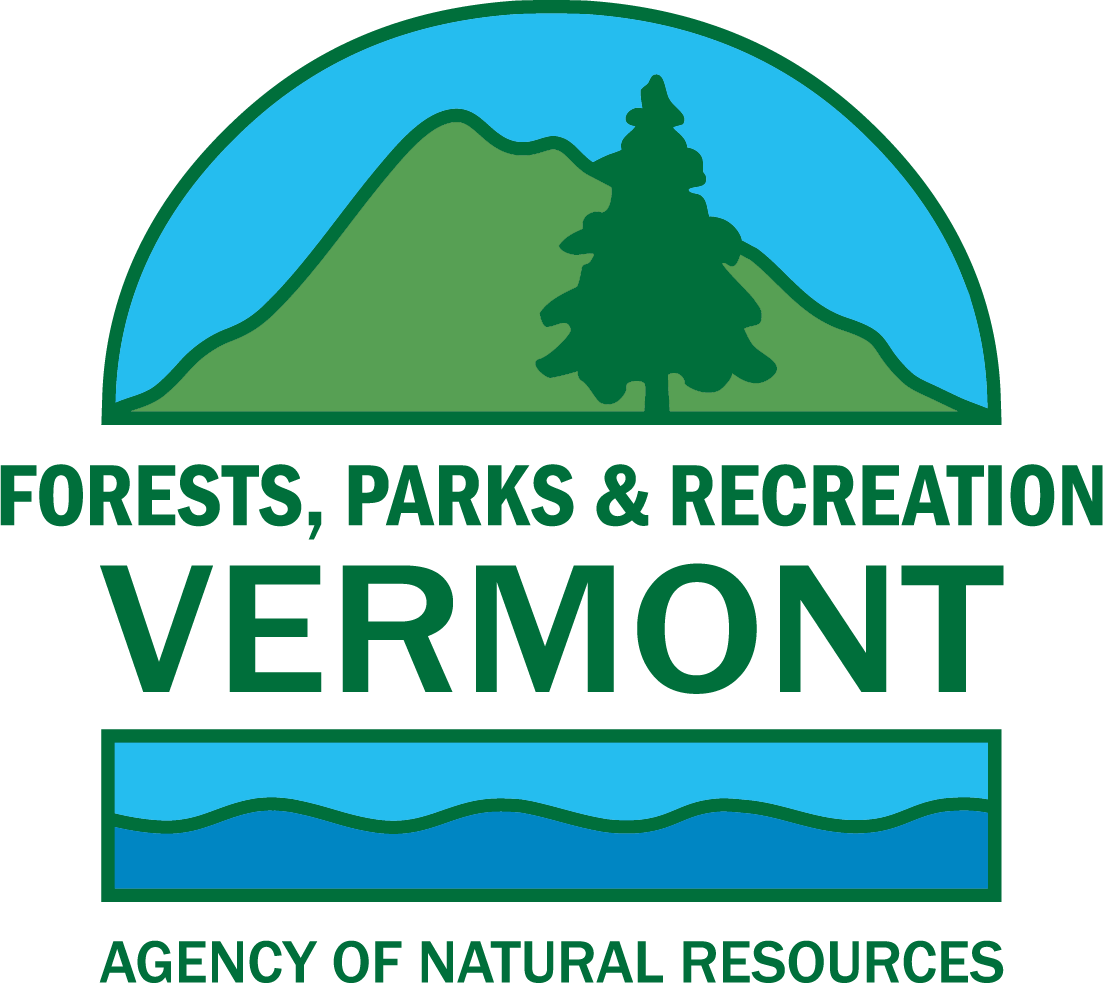Overview
Vermont is famous for its beautiful natural surroundings and Vermont State Parks provides easy access to the flora and fauna of our state.
You can hike through an old growth forest at Gifford Woods State Park, or through a peat bog at Lake Carmi. You are likely to see loons on a visit to Green River Reservoir or a moose at Stillwater. Mt. Philo State Park is a great place to observe the annual fall hawk migration and Burton Island is a great place to watch Least Terns dive for supper.
There is a wide variety of habitat and wildlife in the parks, from the sandy dunes of Alburgh Dunes State Park, to the alpine zone on Mt. Mansfield. You can explore woodlands and meadows, lakes and mountain streams, marshes, mountaintops, islands and cliffs, all in Vermont State Parks.
Interpretive/ Nature Programming
Certain parks employ park interpreters who offer fun, hands-on activities. Interpreters are park staff solely dedicated to helping you learn more about the natural and cultural history of the park. Some popular activities include night hikes, nature crafts and games, campfire programs and amphibian explorations. The following parks have interpreters offering programming in the summer months: Jamaica, Silver Lake, Quechee, Woodford, Emerald Lake, Bomoseen, Half Moon Pond, Lake St. Catherine, Button Bay, Grand Isle, Burton Island, Lake Carmi, Smugglers' Notch, the Groton parks, Little River, and Brighton.
Nature Centers
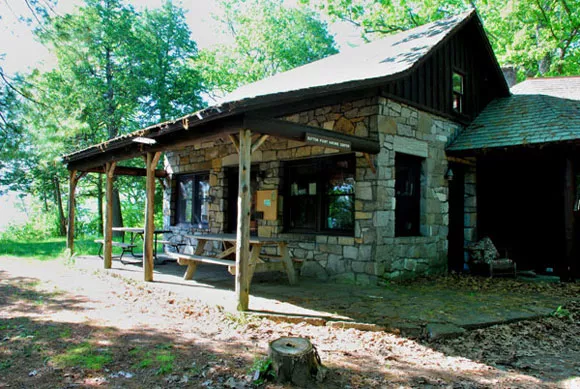
Nature centers are great places to learn about and observe nature. Here is a list of all the Vermont State Parks with nature centers.
Branbury State Park
The area around Branbury State Park is full of interesting local and natural history. Learn more at this nature center, located in the day use area on Lake Dunmore, near the boat launch area.
Button Bay State Park
If you would like to get a close look at some interesting Button Bay buttons, or you want to learn more about the geology or flora and fauna of the area, visit the nature center at Button Bay State Park. Peruse the displays and explore the mysteries of the geologic features of this unique place.
Coolidge State Park
Built by a park ranger and a National Civilian Community Corps crew, this rustic nature center has been funded by donations from people who really care about Coolidge State Park. Although it is a work in progress and displays are not in place yet, you can visit and take a close look at a hand built log cabin. Sit on the porch and take a step back in time.
Grand Isle State Park
Learn about Lake Champlain and the habitat it provides for the flora and fauna of the Lake Champlain Islands at Grand Isle State Park. Displays change regularly and there is a park interpreter on site that provides fun nature programs in the summer months.
Groton State Forest
The heart of Groton State Forest is the newly rennovated nature center, situated in the center of popular hiking trails and the launching off point for Peacham Bog exploration, is home to natural and cultural history displays for you and your family to explore. On an inclement day, sit back and peruse a field guide or play a nature game with fellow campers. Plan your hikes and meet your friends from other areas of the park at this central location. Enjoy a program or activity or just kick back on the porch and watch the tamarack trees blowing in the breeze.
Jamaica State Park
Stop by the picnic shelter and visit the nature center to discover the mysteries of the West River Railroad and history of Jamaica State Park, as well as secrets of the river and forest life in this special place along the West River.
Lake Carmi State Park
Take a break from the beach and learn about the natural and cultural history of Lake Carmi State Park in the nature center. Explore the interactive displays while you learn interesting facts about the place you are visiting.
Lake St. Catherine State Park
Learn about the natural history of the area from this historic nature center, located not far from the beach, playground, and picnic area. There is also an easy nature trail to hike nearby.
Wildlife around Vermont State Parks
Vermont has a variety of animals. Here is just some of the fascinating wildlife that can be observed at a Vermont State Park.
Loons
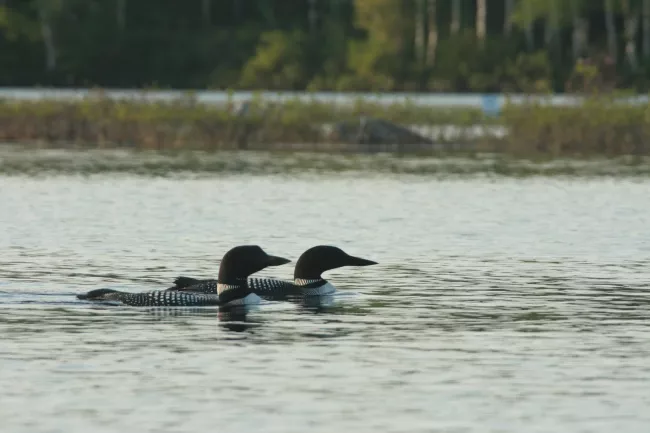
Have you heard the eerie tremulous yodel of the Common Loon at night from your snuggly sleeping bag? You can hear the nighttime territorial call of the male loon from many lakeside parks, including Green River Reservoir, Ricker Pond and Brighton State Parks. The loon is built for swimming and diving in the water, but is not built for walking on land. Loon feet are so far back on their body (which is great for swimming and diving for fish) that they move clumsily on land. Loon nests are built near the edge of the water, or on floating rafts provided by people because loons cannot easily move inland to build a nest. As a result, the nests are very prone to destruction by rising water, wakes from boats washing ashore, or even people and pets exploring the shore. Look for baby loons in July and August riding on the back of the adults or swimming close by. Adult loons are large and streamlined with a black head, checkerboard black and white plumage and red eyes. They dive to eat fish, and during your next trip to a pond with loons, watch them stick their heads under water to look around for fish to eat.
White-tailed Deer
The white-tailed deer can be found in many different habitat types from forests to fields to housing developments. Because of this, the white-tailed deer are an easy animal for nature lovers to find and observe. Deer are herbivores, which means they eat plants. Specifically they enjoy eating twigs, buds, bark and leaves. They are ruminants, which means they have four stomachs like cows do. Being a ruminant has benefits for deer because it allows them to eat all kinds of plant material all at once, then go hide somewhere and lay down while their stomachs go to work digesting the plant material. Deer are active mostly in the morning and the evening. Look for them where forest and field meet at Fort Dummer, Branbury, North Hero and Seyon Lodge State Parks.
Moose
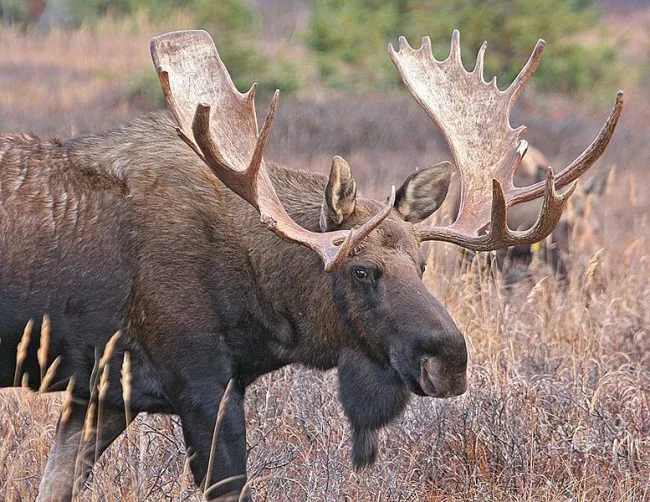
Moose is the Algonquin term for “twig eater.” The largest mammal in Vermont is also one of the most interesting to see. Moose are found most frequently at high elevations in the winter months and in swamps and ponds in the summer. Look for their teeth mark scrapings on the trunks of striped maple trees, the hobblebush buds nipped off completely, or piles of large, round scat and you know that moose are in the area. Moose are active mainly at dusk and dawn; look for them in out of the way places on dirt roads and in ponds near Half Moon, Branbury, and Kettle Pond State Parks.
Beavers
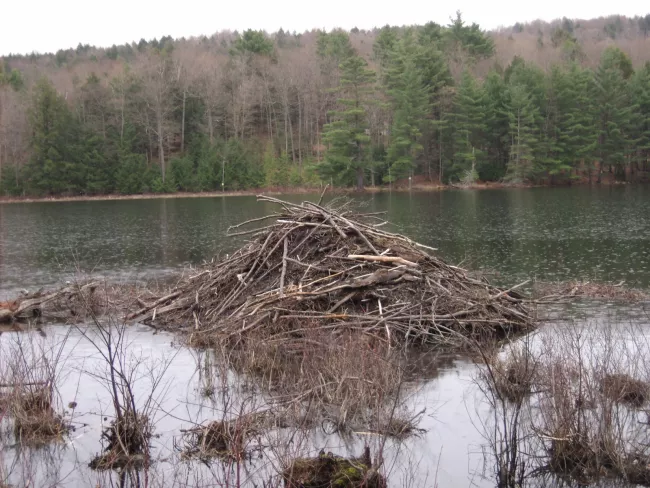
The largest and busiest rodent in Vermont is the beaver. Beavers are very industrious and well known as the loggers of the animal world. Left unattended, beavers will build dams to block running water and often cause problems for farmers and drivers alike. Beavers can be destructive but they are also interesting- they build huts and dams out of sticks and mud and then cut trees and drag limbs underwater for the winter food supply. Beavers have orange teeth with a layer of iron in the front enamel so that they can chew through the trunks of trees that any person would grab an axe or saw to cut through. Beavers are interesting to watch as they swim around with their noses poking out of the water. If you alarm one, it will slap its tail loudly at you. Look for beavers at Silver Lake, Lake Carmi, Camp Plymouth and Emerald Lake State Parks.
Hermit Thrush
If you have ever been walking through the woods in the evening and heard the most beautiful and amazing bird song imaginable, you probably heard the Hermit Thrush. In 1941 this bird was chosen as the state bird of Vermont because of this great song. Some legislators argued for the Blue Jay and Crow as the state bird, but Hermit Thrush fans persisted and the thrush was voted in. The song that propelled the Hermit Thrush into state stardom is a result of a complicated song box that allows the bird to sing two notes at once. The song is a sweet strain of melodic notes that always begins with one long note (the similar Wood Thrush song does not have this long beginning note). The ground nesting bird is brown on the back with a reddish tail, black spots on the chest, and has a thin white eye ring. Listen for this bird as you walk through any mixed hardwood forest in the evening; they have been heard at Molly Stark, Woodford, and Underhill State Parks.
Flowers and Flora around Vermont State Parks
Vermont is also home to a variety of interesting flora. Here are some flowers and plants you might find.
Blood Root
One of the greatest treats in looking for wildflowers is to find a native poppy plant. What can this possibly be? The blood root flower, a small white flower with a yellow center (kind of like a big, low-to-the-ground daisy), with a unique curled leaf can be found in moist forest edges in the spring. Look for these below a row of sugar maple trees next to a road. If you are having trouble finding these, they have been spotted in Branbury State Park.
Maidenhair Fern
You probably have seen all sorts of ferns in the forests of Vermont- from large, tall bracken ferns you could hide under to small, hay-scented ferns carpeting forest openings. If you know what to look for, you may be able to find the uncommon maidenhair fern. This fern has finely textured frilly fronds with curved stalks that appear like large springs unwinding, or like curled locks of a maiden’s hair circling in the breeze. The wiry stems are a dark reddish-brown and the frilly fronds are a deep green. These ferns are uncommon because they grow only in rich soils mostly on wooded slopes. Look for them in the forest at Emerald Lake State Park.
Pink Lady Slipper
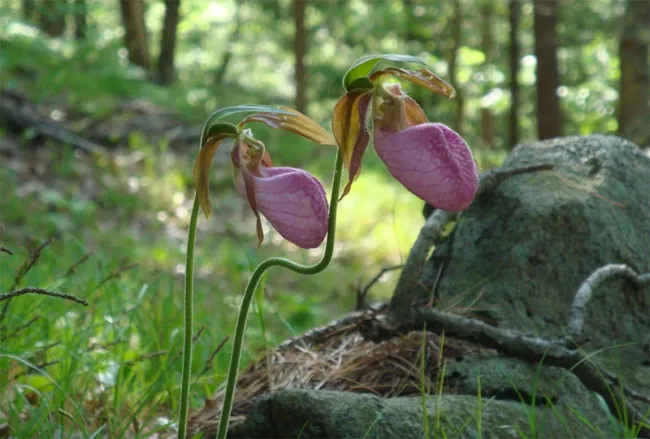
Look carefully for therarenative orchid (the pink lady slipper) under oak and pine trees in moist woods. Lady slippers are a treat to find— look for the two large green leaves on either side of the stem, and the pouched pink orchid flower hanging in the center. These flowers have been spotted in Brighton State Park.
Pitcher Plant
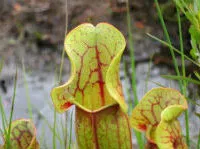
What is a plant to do when it lives in a highly acidic environment with no available nutrients to grow? Digest insects! The pitcher plant adapted to grow in acidic peat bog environments by trapping and digesting insects. Look for the pitcher plant in the peat bogs of Lake Carmi State Park and Peacham Bog in Groton State Forest. This tubular plant has a pitfall trap that lures insects into its watery depths. The sides of the plant’s vase-shaped trap are slippery and have downward facing hairs that prevent the insects from escaping. The liquid at the bottom of the pitcher plant dissolves the insects and makes the insect’s nutrients available to the plant.
Trillium
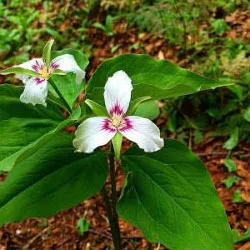
Watch for the deep burgundy petals of the red trillium in the rich soils in Gifford Woods State Park. Later in the summer, this threeleaved plants will have a red berry-like fruit where red flowers can be found in May and June.
Trout Lily
When you walk through the spring forest, look down along the forest floor for the yellow drooping lily flowers of the trout lily. The green leaves, speckled with brown like trout, carpet the forest floor in the early spring in Coolidge State Park.
Trees around Vermont State Parks
Eastern Hemlock
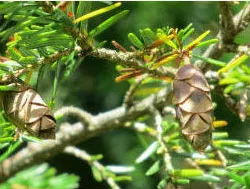
If there was a contest to find the best tree to sit under on the hottest of the dog days of summer, the eastern hemlock would be the victor. These large, evergreen trees provide nice shade in summer and shelter from storms in winter. You can know this tree is from far away by observing its drooping limbs and leaders. The leader of a tree is the very top part of the tree, and only hemlocks have a leader that droops. Because of their many branching limbs, hemlock trees are excellent for climbing. Hemlocks grow very large and can live a very long time— over 500 years! The bark is deeply furrowed and dark brown with reddish inner bark underneath. The needles are short, flat and dark green with two white racing stripes on the underside. You can find groves of these beautiful shady trees in many Vermont state parks, including Little River, Emerald Lake and Woodford State Parks.
Sugar Maple
The most common forest tree in Vermont is also designated as the state tree. It is the beloved sugar maple. Vermont has a higher percentage of sugar maples than any other state in the union. Industrious Vermont maple syrup producers tap over half a million gallons of sap from these trees every spring. Sugar maples are deciduous trees (they lose their leaves in the fall) with five-lobed leaves with smooth edges. The bark on young trees is smooth and gray while on older trees it becomes furrowed and shaggy. We can thank sugar maples for our beautiful foliage because in the autumn they turn bright yellow or orange. You can find these magnificent trees in many state parks, including Mt. Ascutney, Half Moon Pond and Mount Philo State Parks.
Paper Birch
The distinctive white bark of the paper birch tree makes it the easiest forest tree to identify. Look for white thin bark that peels in thin horizontal layers. It looks almost like paper and rolls up into “scrolls” on the ground. The paper birch is the very first tree that will grow in most areas after a disturbance (such as fire). They live about 70 years and new birch trees cannot grow in the shade of adult trees. Paper birch release their small brown seeds in the winter when they are blown out over the snow surface by winter winds. These seeds are a popular food with the winter birds of Vermont. Look for these small, brown seeds on the snow after a windy day. Birch bark is used for many decorative items, such as baskets and wreathes, and it is also a great fire starter. Make sure you use only bark you find on the forest floor because peeling bark off live trees will cause permanent damage to the tree. You can find these beautiful trees in Silver Lake, Smugglers' Notch, Lake St. Catherine and Lake Carmi State Parks.
Tamarack
The tamarack is a very unique, coniferous/ deciduous tree. It has needles and grows cones, but all the needles fall off each autumn. This unique tree is one of a kind, and you can find it in the swamps and wetlands of Vermont. Lake Carmi State Park and Stillwater State Park are two places to find lots of these interesting trees. Look for light green needles in clumps of 10-20 that feel soft in the summer and turn bright yellow in the fall. The tamarack bark is light brown and flaky with reddish inner bark underneath.
Spending Quiet Time
Sometimes you just want to get away from it all and enjoy some peace and quiet out in nature. Maybe you're looking for a quiet place to spend the afternoon, or maybe you're looking for a weekend or week of R&R camping.
Vermont State Parks makes it easy to get out and spend some quality quiet time.
Here are a few of our favorite quiet places to spend an afternoon:
- Knight Point State Park: Located in northwest part of Vermont in the Lake Champlain islands, Knight Point State Park offers wide expanses of lawn and mature trees, a quiet beach, and a nature trail that leads to a beautiful, secluded point on the lake. This is the perfect spot to enjoy Lake Champlain away from the big crowds.
- New Discovery State Park: In northeastern Vermont and serving as part of the 26,000-acre Groton State Forest lies Osmore Pond, part of New Discovery State Park. This is a great, quiet place to spend a peaceful afternoon. New Discovery State Park was built by the CCC (Civilian Conservation Corps.) in the 1930's and the rustic log picnic shelter and four log lean-tos around the lake are legacies of their work. There are also quaint picnic spots hidden here and there with stone fireplaces built by the CCC. There is a trail around the lake and loons are a common sight.
- Kettle Pond State Park: Also in the the Groton Forest, Kettle Pond State Park is a quiet gem. You'll need to hike in about a quarter mile from the parking lot to get to the pond, or portage your boats if you want to paddle, but its well worth it. There is a trail that goes all the way around the lake, several remote lean-to's and great rocks to lay on and soak up the sun. Plus, you're likely to see loons!
- Allis State Park: In central Vermont, Allis State Park is definitely off the beaten path. This park was also built by the CCC and it has a CCC-built log picnic shelter and stone fireplaces throughout the park.There is a fire tower you can climb that has spectacular views and the Bear Mountain Trail gets you into the woods and has several very nice places to sit and take it all in.
- Lowell Lake State Park: Near Londonderry in southern Vermont, Lowell Lake State Park is one of the newer additions to the state park system and at this time remains in an undeveloped, natural state. It is a great place for a quiet paddle or a walk on the trail that winds its way around the lake.
Quiet Places to Sit by a Stream
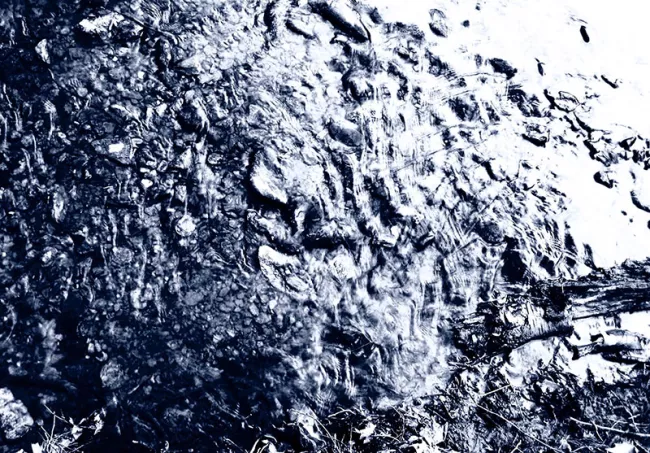
Northwest:
- Lake Carmi State Park, Sucker Brook: Near the entrance of the nature trail, you can access Sucker Brook. It twists and bubbles around two old farm sites then snakes through a group of hemlock. You can sit along its banks or skip stones in the calmer pools. The beauty of this gem is that around the 1st of May you can stand on the foot bridge (fifty yards from the nature trail sign) and enjoy the sucker fish running up the brook from Lake Carmi on their spring spawning run. Whether you want to watch the fish or just listen to the running stream of water, Sucker Brook is a place to explore and relax.
- Underhill State Park, Un-named Brook: An unnamed brook can be found running parallel up the Mountain Road, to the west of Underhill State Park. You can access many quiet spots along this brook by going off trail to the left, after passing through the orange park gates beyond the upper parking lot. It's about a 10-15 min hike down to the babbling water. Once there, you'll see how it meanders through the lush green forested vegetation of Mt. Mansfield. The stream passes by the north side of the campground, protected by a steep sided valley. Pick a mossy cobbled place anywhere along here to spend an hour or more.
Northeast:
- Little River State Park, Stevenson Brook: Stevenson Brook flows along the nature trail with convenient parking at the trail head. In spring and early summer, you will notice a briskly moving ice cold brook, but as the season moves on the water slows to a babble. Rays of sunlight filter through the dense canopy and make it the perfect spot to read or spend the afternoon exploring. You may find beavers, a variety of birds, and many different kinds of wildflowers and ferns.
- Ricker Pond State Park, Wells River: Generally a rapid stream, the Wells River provides a great amount of places for swimming, paddling, and fishing, but also serene spots for contemplation. Explore all along the river by stopping at one of many pull-offs along Route 302 between Groton and the Town of Wells River. This river has its source at Kettle Pond and runs southeast for about two miles (Stillwater Brook) and falls into Groton Lake. From Groton Lake it continues over Groton Dam. The river in between this dam and Ricker Pond is a popular spot to stroll, wade in the water, or picnic. Where the river flows over Ricker Dam at the south end, there is a popular spot to swim, paddle or fish. Parking is available at this location. From the south end of Ricker Pond the river continues a mile and a half and meets up with the South Branch. It travels east and meets up with the main stream; it then runs southeast for about a mile and receives the North Branch. Continuing the same course it passes through Ryegate and Newbury on its way to the Connecticut River.
- Groton State Forest, Depot Brook: Depot Brook can be accessed by the Cross Cut Trail or Depot Brook Road. To reach the Cross Cut Trail, start on the Montpelier-Wells River Rail Trail ½ mile north of Ricker Pond State Park. Continue west .1 miles; cross Route 232 where you can proceed to the intersection of Depot Road. To access Depot Brook Road, proceed down Beaver Brook Road, past Silver Ledge Trail to a turn off onto Depot Brook Road on the left. There is no official trail to Depot Brook. Bush Whacking to this slow running stream is the only option. Again, there is the potential to view an abundance of wildlife. Groton State Forest Trails Map and Guide (PDF)>>
- Groton State Forest, Stillwater Brook: This brook starts at the outlet of Kettle Pond and eventually travels through Stillwater State Park and into Lake Groton. Parking is available at the Kettle Pond Day Use parking lot. Directly across from the Kettle Pond Campground is a trail leading to the Montpelier/Wells River Rail Trail and a view of Stillwater Brook. Once on the Rail Trail look to your left and you can view a small cascade from the wooden bridge. The rest of the stream is mainly accessible by bush whacking. Where it crosses the Boulder Beach Road and into Stillwater Campground, there is a view of the stream with Owl’s Head and Big Deer Mountains in the background. The swampy area right in front has been an excellent moose viewing area. Groton State Forest Trails Map and Guide (PDF)>>
- Groton State Forest, Coldwater Brook: Coldwater Brook can be accessed from the trail systems originating at the Groton Forest Nature Center. Coldwater Brook originates from Peacham Pond and eventually dumps into Lake Groton. The Coldwater Brook trail parallels the stream for a short distance. As the name implies, this relatively fast moving stream is very cold. You can access from the trail a number of small pools in which to wade if you have the courage. For history buffs, the remnants of a stone foundation to an old mill can be seen. It is believed to be a small up-and- down sawmill which operated before the Civil War. Groton State Forest Trails Map and Guide (PDF)>>
- Groton State Forest, Hosmer Brook: Hosmer Brook may be accessed from the Hosmer Brook Trail. Parking is available at the Groton Nature Center. Hosmer Brook runs from the outlet of Osmore Pond approximately 2 miles to Lake Groton. This quiet stream can be accessed midway along the Hosmer Brook hiking trail. There are numerous places to relax by this slow moving stream, while enjoying the quiet woods. Groton State Forest Trails Map and Guide (PDF)>>
- Seyon Lodge State Park, South Branch Wells River: Seyon Lodge is located three miles down Seyon Pond Road in Groton. The South Branch of the Wells River originates where Noyes Pond spills over the dam. After checking in with staff at Seyon Lodge, take a short walk to the pond and off to the right you will see the dam. Fishing is not allowed in any of Noyes Pond’s tributaries, however hiking and picnicking are popular activities.
Southwest:
- Bomoseen State Park, Glen Lake North End: Walk the trail starting from the Glen Lake information board on Moscow Road, just north of the Bomoseen State Park contact station. Stop along the way at one of the points where the trail touches the shore or walk about 1600 meters to the crossing at the north end of Glen Lake. This stroll will be quiet as long as the slates mines in the industry don't start up again.
- Button Bay State Park, Button Point: Follow the trail west along Lake Champlain for about 10 minutes. You’ll see the nature center once you’re close. A trail from the nature center to the lake leads you to a set of large rocks on the water. This is a quiet spot where the lapping water comes over the rocky shore. Some fish from this point, but we think it's even better for laying on a warm rock and taking in some rays. *Note: Please stay on designated trails as there are sensitive species and rare plants in the area.
- D.A.R. State Park, Observation deck on Lake Champlain: Just beyond the playground, follow a trail to the stairs leading to D.A.R.’s Observation Deck. This area leads to a quiet rocky beach where the sounds of the lake waves and wildlife surround you.
- Emerald Lake State Park, South end of Emerald Lake:Walk from the day use beach around the lake on the trail to the point where water flows out about 1000 meters. Relax in this spot and take in the wildlife. Look for ducks and beavers, especially in early morning hours.
- Woodford State Park, East end of Adams Reservoir:Hike from the day use beach along the south side of reservoir for about 1000 meters. This peaceful area has sounds of lapping water and wildlife. Find a spot to sit, close your eyes, and listen.
Southeast:
- Mt. Ascutney State Park, Crystal Cascade Falls: The eighty-foot falls can be accessed by parking at the Weathersfield Trail trailhead off of Route 131 on Cascade Falls Road. From the Mt. Ascutney State Park office, go 2.3 miles south on Route 44A and Route 5 to intersection with Route 131. Turn west on Route 131 and go 3.5 miles to intersection with Cascade Falls Road, turn north on Cascade Falls Road, follow signs to trail head. Hike 1.2 miles and you're there! This incredible spot is a great place to sit and listen to the thunder of the falling water. The view is actually quite good from the base of the falls, but this requires a difficult bushwhack down a very steep slope. The falls are primarily surface flow, and water flow is minimal unless there is significant rain.
- Camp Plymouth State Park, Buffalo Brook: Buffalo Brook runs through the park , a few hundred feet south of the park entrance, and flows between the picnic pavilions and the group camping area. A short hike on the east side of Scout Camp Road behind the rental cottages leads along old logging roads which parallel the brook, providing a very scenic natural experience. Despite its proximity to Camp Plymouth’s popular beach and day use area, a short stroll along the banks of Buffalo Brook allows visitors to enjoy the sights and sounds of the stream and the nature that surrounds it, in peace and quiet. Enjoy this one!
- Coolidge State Park, Whetstone Brook: Turn left on Ranger Road, approximately 0.3 mile north of the park entrance. There is a small parking area near a wooden snowmobile bridge that crosses the brook. Whetstone Brook is a small stream off the beaten path which makes for a calm place to relax and let the water run over your toes.
- Gifford Woods State Park, Thunder Falls: To access these falls, travel about one mile east of the park along the Appalachian Trail. You can also access the falls by a newly constructed boardwalk off of Thunder Brook Road. This cascade down a rocky slope is surrounded by forest. Work your way along the stream that comes from the falls to lead you to Kent Pond.
- Jamaica State Park, Cobb Brook, Hamilton Falls, and sections of the West River Trail: Although a little more popular than some of the other brooks and streams listed, Cobb Brook and sections of the West River Trail can be perfectly peaceful if timed right. A 2.5-mile section of the West River Trail begins at the parking lot in the park’s day-use area. The trail is a converted railroad bed which runs parallel to the river. Universally accessible and very popular with walkers, joggers and bikers, this trail gives all ages a chance to enjoy. Look for “The Dumplings,” a group of large boulders about 1 mile up the trail. Follow the trail for another 1.5 miles to reach Cobb Brook. At the 2-mile mark the trail intersects with the Hamilton Falls Trail. Follow this 1.1 miles to the base of the 125-foot cascade that is Hamilton Falls. For a better chance of having the place to yourself, try going on a weekday.
- Molly Stark State Park, Beaver Brook: Beaver Brook flows down Mt. Olga where it crosses the base of the Mt. Olga trail, flowing under a small footbridge, and then follows the park entrance road to the intersection of Route 9. The small stream is easily accessible in this fairly quiet park. Lucky visitors may see small trout darting across small pools located at the base of the Mt. Olga Trail.
Quiet Places to Camp
Sometimes its great to camp with a bunch of family and friends in an action-packed park on a big lake or near popular hiking trails or tourist attractions. But sometimes, you might want to have more of a quiet camping experience.
You might be surprised to hear that you can usually find quiet - or more quiet - camping at most any park midweek, in May or June, or after Labor Day.
Some parks, though, stand out as our favorites for quiet camping. These tend to be smaller parks that attract visitors of the quiet kind. Here are our top picks for quiet camping:
- Knight Island State Park and Woods Island State Park are secluded islands on Lake Champlain. You can only get to these parks by boat - power boat, sail boat, canoe or kayak. Knight Island has seven secluded lean-to's and one campsite. Woods Island has five secluded campsites. These sites can be reserved in advance. Both islands have sweeping views and epic Lake Champlain sunsets. Both islands have a network of trails. If you ever wondered what it might be like to have your own island, these parks are for you and are well worth the challenge of getting there.
Big Deer State Park and Ricker Pond State Park: In the northeastern part of Vermont is the 26,000-acre Groton State Forest. Within the forest you will find six state parks, each with its own, unique character. For quiet camping in the Forest, try Big Deer State Park, which is just across the road from the busy Stillwater campground. Because Big Deer isn't on the lake, it tends to be quiet, and the lean-to's and tent sites are situated in beautiful, mature woods. When you're ready for a swim, lake access is just a short drive or bike ride away.
Ricker Pond state park, is a quaint little park located on, yep -Ricker Pond. You can access great biking from the Cross Vermont Trail which intersects the park. Loons and friendly mallards are park residents. In both parks you can access the multitude of trails, lakes and ponds of the Forest, or visit the Groton Forest Nature Center.
- Seyon Lodge State Park: At the Southern edge of the Groton State Forest is the unique Seyon Lodge State Park. Its not a campground at all, but a lodge-style inn. Seyon Lodge is located on Noyes Pond, which is the only public trout fly fishing pond in Vermont. There is a trail around the lake, and again, access to all the forest's recreational opportunities. While you are staying in any Vermont State Park, you can visit all the others for no additional charge. The Lodge offers single and double room accommodations, serves fantastic home made meals with fresh Vermont ingredients and is a favorite for a peaceful getaway.
- Brighton State Park: Way up in the Northeast Kingdom of Vermont is Brighton State Park. The park actually has two distinct recreation areas: a large day use beach located on the large lake, Island Pond, and a quiet campground that surrounds the shores of Spectacle Pond. There are trails to hike around the lake, a hidden amphitheater, a beautiful campers beach, play areas and a nature museum.
- D.A.R. State Park: In the western part of the state, on Lake Champlain is D.A.R. state park. Although it is on the lake, there is no swimming beach at this small park, which tends to be quiet. Situated on a bluff overlooking the lake is a beautiful stone picnic shelter with Adirondack chairs for you to sit back and enjoy the view. There are sweet lawns and this park has a huge population of cottontail rabbits. You can swim at the newly built pool at nearby Button Bay State Park. There is also great bike riding in the area.
- Mt. Philo State Park: Mount Philo State Park, with its expansive view of the Champlain Valley is one of the most popular day use parks in the Vermont State Park system, but believe it or not - it is one of our most quiet campgrounds. There are only seven campsites and three lean-to's at this park, making it one of our smallest campgrounds. In the quiet of the evening, it is a special treat (especially in bright moonlight) to visit the top of the mountain and look down at the valley below.
- Coolidge State Park: Located within the 21,500 acre Calvin Coolidge State Forest, Coolidge State Park is another park in our system that was constructed by the CCC. There are still the log lean-to's with handmade tables and stone fireplaces. The road to the park is too steep for large RV's, and because it's not located on a lake, this park tends to be very quiet. Some of the lean-to's have the most magnificent views in the parks and are favorites, particularly during fall foliage season.
- Townshend State Park: Another gem, this park is just down the road from busy Jamaica State Park. It too is a small park not suitable for RV's and has beautiful stone CCC-era buildings. There are tent sites, tent platforms and a couple of lean-to's. Several streams run through the wooded park and the sound of trickling water and birdsong are prevalent. On Saturday night, the rangers Pat & Gary play guitar and welcome campers to participate in an open mike sing-a-long. On the river nearby, there is a covered bridge with rope swing, or you can visit the large Townshend Dam Recreation area, with large lake and beach run by the Army Corps. of Engineers. You can also take a trip to nearby Jamaica State Park and walk on the West River Rail Trail or the trail to Hamilton Falls.

